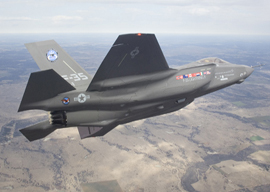
January 01, 2012

F-35
Ask any grunt on the ground if he’d rather call in close air support from a fragile F-16 traveling at close to the speed of sound, a helicopter (the Army’s close air support choice) or the Warthog. They’ll pick the A-10 if they can get it. Yet the Pentagon wants a bunch of F-35s; supersonic, high-flying, cannonless, radar-proof fighters with virtually no resistance to small arms fire.
The best close air support in the Vietnam War didn’t come from the supersonic blunderbusses the military-industrial complex was turning out at the time, it came from the WWII-era Douglas A-1 Skyraider, nicknamed the Spad. This was a 1940s design which ended up being the most useful aircraft in the Vietnam War, mostly because it wasn’t a fragile, supersonic wonder weapon. Like the A-10, it was heavily armored, slow-moving, and had lots of big guns with plenty of ammunition. If we need new close support aircraft for the Marines, it seems more sensible to me to build or refurbish a tough plane with lots of armor and guns on it. This has been proven in combat multiple times. We do not need a stealthy, supersonic, gunless monstrosity.
The F-35 wouldn’t be a great idea even if it was cheap and wonderful. Assuming everything else works, there isn’t much of a wing on the thing. Wings help airplanes turn. The issue with turning is a serious one. Our Air Force had a hard time in Vietnam against outdated Soviet fighters in part because we didn’t have any fighter planes which could turn. A lone genius named John Boyd eventually figured out what was going wrong and helped the Air Force develop our present generation of jet fighters, which are actually very good at turning and shooting down other jets. They say the F-35 is supposed to be good at turning, but the fact that it has the same wing loading as an F-105 makes me doubt this. They also said it would be cheap and delivered on time.
The F-35 program should be a national scandal. It is unarguably a very costly design which solves nonexistent problems. Worst of all, we’ve invested so much money in the damn fool thing, we don’t have any viable alternatives to replace our aging air fleet. Even the Soviet Union, a nation mad enough to use central planning to determine how many toilet-paper rolls to produce each year, used multiple design bureaus to come up with their fighter planes. Somehow, central planning’s disadvantages are lost on modern America.